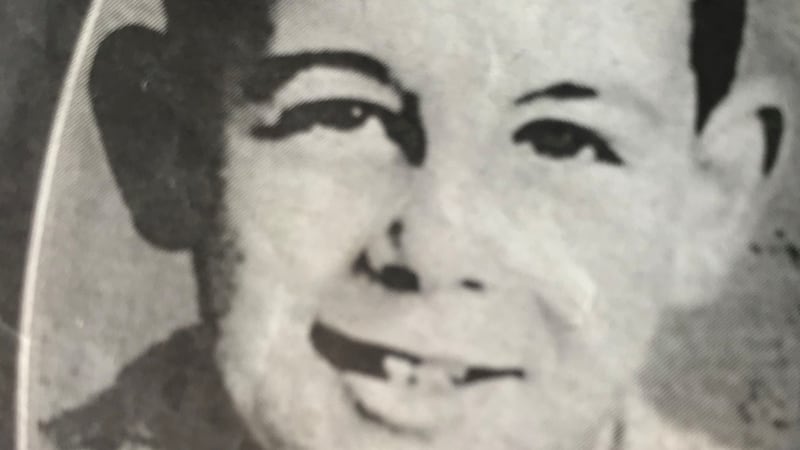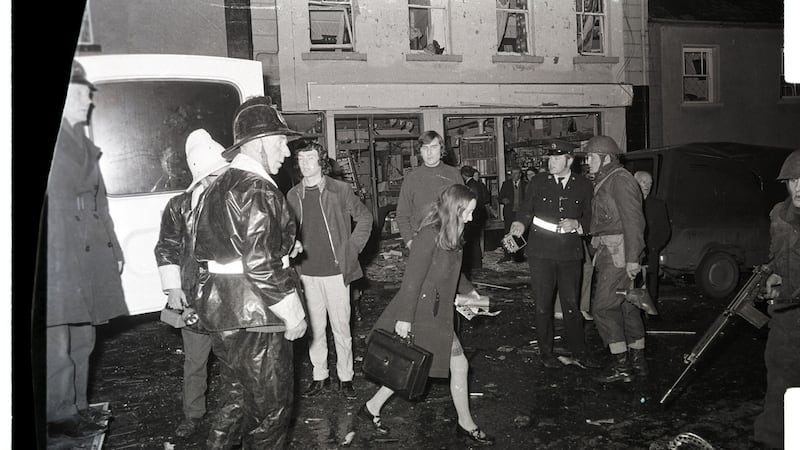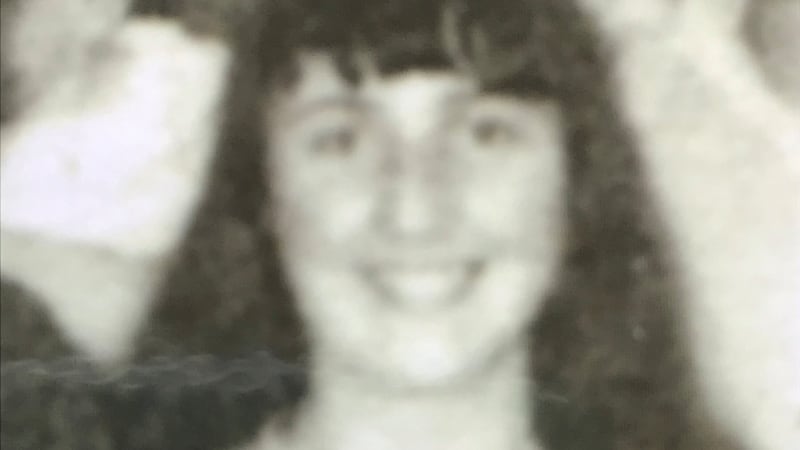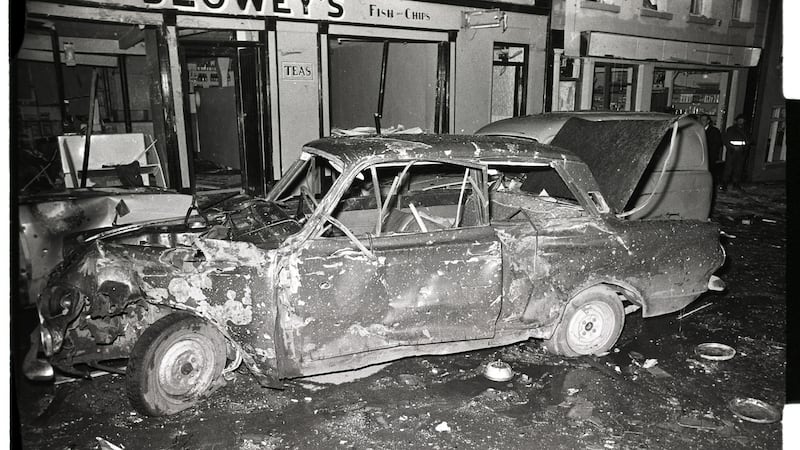December 28th was the Catholic feast day of The Holy Innocents, Joseph Stanley often recalled in the years that followed 1972, the day that everything changed.
On that day in 1972, at 10.01 pm, his son Paddy – a sports-obsessed teenager – had been trying to telephone his family in Clara, Co Offaly.
His son (16), who worked as a delivery assistant on a lorry supplying gas cylinders to businesses around Ireland, was in Belturbet, Co Cavan. He needed to call home. There was one more delivery to make and the shop in the Co Cavan border town of Belturbet was closed. They would have to spend the night in Cavan.

As he was standing in the public phone box on the town’s main street, a bomb in a nearby parked car exploded. Lifted by the explosion, the box was thrown a number of yards.
Local mechanic Paddy O'Reilly rushed to help, finding Paddy Stanley by the phone box: "I … carried him up the street towards the garage. His hair was burning, and half his face was blown away," he said.
Fifteen-year-old Geraldine O’Reilly had been about to leave a takeaway when the bomb exploded. Her brother, Anthony, had been waiting for her in his car. Seriously hurt and requiring hospital care, he was, nonetheless, taken to identify his sister’s body by torchlight. He did so by recognising one of her tan, knee-length boots, her blue skirt and other fragments of clothing.
Both Geraldine O’Reilly and Paddy Stanley suffered catastrophic head injuries, dying instantly. Several others were treated in hospital for serious burns and lacerations. Today, their trauma endures.
Anthony O’Reilly remains profoundly affected by that flickering vision of his sister’s body on the takeaway floor: “Last thing at night and first thing in the morning, that image still comes back to me. It’s not something you get over.”
No charges
Almost 50 years after the Belturbet bombing nobody has been charged with the murders of the two children and the injuries to so many others.
A 2004 report by former High Court judge Mr Justice Henry Barron named one lead suspect, Robert Bridge, an Enniskillen loyalist who was later convicted of a sectarian murder.

Bridge was the most likely leader of a loyalist cell in Fermanagh that planted bombs in the southern Border towns of Belturbet, Clones and Pettigo on the night of December 28th. Fortunately, nobody died in Clones and Pettigo.
Barron's conclusions drew heavily on Garda reports, which were largely based on intelligence received from the Royal Ulster Constabulary. Barron singled out Bridges because there was so little information about anyone else.
However, documents held at the UK National Archives in London now prove that intelligence on another lead suspect was available, but that this was not passed on to Irish investigators.
Barely three months after the murders in Belturbet, the commander of the British army's 3rd Infantry Brigade, Brig Peter Bush, met Tyrone and Fermanagh police commanders in Omagh to discuss Border security.
There, they discussed the arrest of two men after a robbery in Derrygonnelly, Co Fermanagh, including an Ulster Defence Association member involved in "a commando-type gang from Belfast" blamed for explosions "in Eire".
On March 14th William McMurray, Newtownabbey, Co Antrim, and James Campbell, a former customs officer with addresses in Fermanagh and Newtownabbey, were arrested and charged with stealing £312 from a man in Derrygonnelly and the illegal possession of a Walther pistol and ammunition. British military intelligence identified McMurray as the "OC [officer commanding] of a UDA special commando team" in the border region.
A few weeks later a 3rd Brigade intelligence summary noted that, in the case of Fermanagh, “there has been no militant Protestant activity during the period under review. This can be accounted for by the recent arrest of McMurray and Campbell on 14 March. It is assumed that the Co Fermanagh militant Protestants are undergoing some form of reorganisation”.
‘An advantage’
British army intelligence reports also indicated that McMurray was an associate of Robert Bridge, who was described as a “lieutenant-colonel” and possible one-time commander of the Fermanagh/Tyrone UDA.
In court in May 1973, McMurray described himself as a "liaison officer" between the Belfast UDA leadership and loyalists in Fermanagh and Tyrone. Three successive juries failed to agree on whether to convict both men and charges were ultimately dropped – although McMurray was convicted of another, separate firearms related charge.
The UDA was a new, legal organisation in 1972; it received support from some prominent unionist politicians. In November 1972 the Enniskillen-based Impartial Reporter newspaper reported on a speech made by John Taylor, a former Northern Ireland cabinet minister with responsibility for security at the Ministry of Home Affairs (1970-1972), in which Taylor " thanked God for the imagination of the people who had the wisdom to form organisations like the LAW [Loyalist Association of Workers] and the UDA", although he believed that, "these forces must be co-ordinated and led".

The unionist-leaning Impartial Reporter reported Taylor claiming that security had improved on the southern side of the Border after loyalist bombings in October 1972 in Clones, Co Monaghan and Carrigans, Co Donegal.
“To that extent one must not hesitate to say that these two explosions have been an advantage to Northern Ireland security,” the newspaper recorded Taylor as saying.
In late 1972 and early 1973 there was a spike in loyalist activity along the Fermanagh Border, including cross-Border bombings and robberies. Whereas Barron believed that Robert Bridge was the driving force behind the group that carried out this loyalist border campaign, including the murder of Geraldine O'Reilly and Paddy Stanley, the British Army and the RUC had come to a different conclusion – McMurray was their primary suspect – one they did not share with their Garda counterparts.
According to Barron, in 1973 Garda intelligence identified a former customs officer who they believed was the leader of a group of loyalist paramilitaries operating on the Fermanagh/Donegal Border.
However, gardaí were unable to interview the suspect as “he was resident in Northern Ireland” (the suspect, unlike Bridge, is not named by Barron and no more comment was offered by Barron on this intelligence).
Retaliation
Some locals were in no doubt that the Belturbet bombing was in retaliation for the order by Cavan County Council to reopen a bombed road linking Enniskillen to Dublin, against the wishes of the British government and local unionists.
The road was hated by local Protestants because it was frequently used by IRA units based in the Republic who crossed to kill part-time Ulster Defence Regiment (UDR) soldiers and blow up Protestant-owned shops and pubs.
On September 21st, 1972, 53-year-old Tom Bullock, a popular part-time UDR soldier and his wife, Emily, were shot dead in their home near the Border by an IRA unit which had crossed over, and returned by, Aghalane Bridge.
Outraged unionists demanded the closure of the bridge. The British could shut minor roads but shutting a main “approved” road required Dublin’s consent and that would not be forthcoming.
However, records now held by the Imperial War Museum show that Capt Vernon Rees, the army officer in charge of security in southwest Fermanagh, believed he could help solve the problem of Aghalane Bridge.
In an interview for the museum's oral history archive, Rees recalled that, after the killing of the Bullocks, a local RUC chief inspector introduced him to Jack Leahy, a 46-year-old publican in Lisnaskea and long-standing Ulster Unionist Party councillor.
Rees claimed that Leahy was a leading representative of the UDA in south Fermanagh. In Capt Rees’s view, “… anybody who would help me defeat the IRA would be a friend of mine. And that in those days included the UDA”. By Rees’s account, Leahy asked him to keep his soldiers away from the Aghalane area on the night of November 20th/21st. Rees had a moment of nervous reflection,
“Am I about to cooperate with a terrorist in the Ulster Defence Association in the destruction of a main road in the United Kingdom? And I thought, ‘All those little farmers around there. They have never used that road. It’s just far too dangerous. It would be wonderful if that bridge was down.’ So I leaked it through the Special Branch again that there would be no soldiers in that area between eight and midnight that Thursday night.”
At 1 am on November 21st, 1972, a Garda patrol car found a string of bales blocking their approach to Aghalane. On top of the bales was a sign marked “BOM” [sic]. Seconds later an explosion ripped through the 19th century, 40ft long bridge. However, the structure was only partially damaged.
Rees later described what happened when he arrived on the scene the following day, where he introduced himself to an army explosives expert.
“I said … ‘I’m Capt Rees. I’m very glad you’ve come out to look at this. There’s some very unstable explosives up there and I don’t want it moved really. I want you to destroy it on the bridge.’ He went up and he came down and he said, ‘It’s mud.’ And I said, ‘No, no, it’s not mud. It’s unstable, homemade explosives.’ And he said, ‘If I blow that up there, sir, it will blow the central arch down.’ And I said, ‘If that’s what happens, that’s what happens.’ And he said, ‘Are you telling me …?’ And I said, ‘Go up there and clear that thing.’ Anyway, he blew it up with about a quarter of a pound of PE [plastic explosives]. Both the arches flew out and the central arch collapsed. Ten minutes later I go up and there is this inspector from the Gardaí who says, ‘What have you done?’”
Temporary bridge
Lieut Gen Harry Tuzo, the most senior officer in Northern Ireland, made it clear to the Northern Ireland Office that he was “delighted” that the bridge was now closed, and he wanted it kept that way.
On the other side of the Border, engineers from Cavan County Council believed that they could erect a temporary bailey bridge. Despite the two explosions, much of the bridge remained intact.
In Dublin, Frank Steele, an MI6 officer, passed a message to the Irish government through the embassy in Dublin – warning that the road's reopening would go against "courtesy and perhaps of law".
Such remonstrations were ignored; the temporary bridge was installed, and the road was reopened on December 24th, 1972. Barriers erected by Fermanagh County Council on the northern side were removed by local nationalists.
Reflecting the feelings of many local Protestants, councillor John Brooke, however, was outraged, describing the bailey bridge as "an invasion of United Kingdom territory by a foreign power".
On the night of the Belturbet bombing, the bomb car, a red Ford Escort, crossed over the bailey bridge. A garda noted the licence number, but quickly waved the male driver and female passenger on.
The crossing by the temporary bailey bridge was not accidental. Other, safer routes were available. But this was likely a warning to the Irish government, as some in the British army were quick to recognise.
Writing to an official in the Northern Ireland Office three days after the Belturbet, Clones and Pettigo attacks, Lieut Col Anthony Millen observed that, “… these incidents should encourage the Republic’s authorities to support our wish to leave the road physically (opposed from legally) closed”.
Extending his sympathies to the Belturbet victims, Cllr Brooke noted that the unilateral reopening of the Aghalane Bridge meant that loyalists could use it just as easily to inflict terror on the people in Cavan as the IRA did when attacking targets in Fermanagh. Brooke hoped that Irish government policy would now change.
Early on January 11th, 1973, Aghalane Bridge was again bombed. A Fermanagh nationalist politician John Carron appealed to Dublin not to be bullied. Repair it, he said, and dare the bombers to try again.

The government ignored Carron’s request. Aghalane was closed for more than two decades. In the weeks after Belturbet, politicians and businessmen demanded extra security on the southern side of the Border.
Belturbet’s town commissioners insisted on 24-hour security on the remaining Leggykelly Border crossing, while locals demanded systematic checks on vehicles, “the same as they were doing in Northern Ireland”.
Under pressure, Jack Lynch’s government stepped up security in Cavan and Monaghan, an outcome welcomed by the British army and mainstream unionist representatives, who noted increasing numbers of arrests of IRA suspects.
The loyalist Border campaign of the early 1970s was a brutal attempt to force the Irish government to do more to secure the Border and counter IRA activity. From that perspective, it can be argued that it worked.
Increased Defence Forces and Garda action frustrated possible future loyalist attacks, but it also served to restrict the IRA's ability to operate in the Border region.
But the bombing of Belturbet, like other loyalist attacks South of the Border, did irreparable damage to the British government’s reputation along that same Border.
An editorial in the Fermanagh Herald observed that: "People are not fools. They see Unionist terrorists doing pretty well what they please." On Aghalane, Lord Kilbracken, the Leitrim peer and decorated Royal Navy pilot, told the House of Lords that it was, "remarkable that the destruction of a bridge by terrorist forces should be considered an act which is indispensable for security purposes".
In addition, the belief among nationalists that loyalist terrorism was ignored, tolerated or even helped by the British army and the RUC severely undermined any attempts they could have made to win trust.
Dr Edward Burke is an assistant professor at the University of Nottingham
RTÉ Investigates will present Belturbet: A Bomb That Time Forgot, RTÉ One, 9.35pm on Monday, which will reveal new evidence about the bombing


















